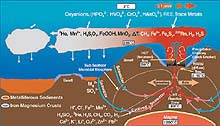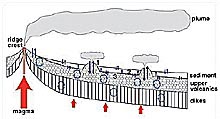
Volcanic heat at the mid-ocean ridge axis drives hydrothermal circulation and chemical exchange between the ocean crust and seawater. (Modified from Massoth et al., 1988.) Click image for larger view and more information.
Hydrothermal Vents and Ocean Chemistry
Context of Hydrothermal Venting in the Chemical Balance of the Earth
David A. Butterfield
Joint Institute for the Study of the Atmosphere and Ocean
University of Washington and NOAA Pacific Marine Environmental Laboratory
The oceans are the largest reservoir of water on Earth. The interactions between the Sun, the solid Earth, the atmosphere and the oceans are important in maintaining the chemical and thermal balance that supports life on our planet. The Sun drives the patterns of evaporation and winds that generate rain and snowfall. Precipitation reacts chemically with rocks and soils, and transports solutes in streams and rivers into the ocean.
The ocean crust is created by the largest volcanic features on the planet—the mid-ocean ridges. Along these volcanic ridges lies a hidden, but equally important, cycle of water transport that plays a key role in maintaining the chemical composition of the oceans. Volcanic heat drives convection of seawater through the permeable ocean crust. The reactions that occur during this circulation remove some elements from seawater and add others. On a global scale, the removal from or addition to seawater via hydrothermal circulation is of equal magnitude to the input from river sources for some elements.
Many metals are enriched in hydrothermal fluids by a thousand to a million times over their concentration in normal seawater. Primordial helium (the stable isotope 3He), present at the formation of the Earth, continues to leak out of the Earth's mantle at mid-ocean ridge hydrothermal vents. It eventually enters the atmosphere when deep water wells up to the surface. Elements enriched in hydrothermal fluids are delivered to the ocean at hot or warm vents, and the effluent can be tracked by sensitive measurements, in some cases for hundreds to thousands of kilometers from the hydrothermal sources.
The Magnitude of the Hydrothermal Chemical Exchange

Schematic diagram illustrating hydrothermal circulation (Adapted from Butterfield et. al., 2001). Click image for larger view and more information.
Clearly, the deep ocean is too vast for us to measure the hydrothermal chemical exchange on a global scale. Therefore, we must understand systematic patterns in order to estimate this exchange. Perhaps the simplest way to model the global hydrothermal system is to consider the heat exchange on the mid-ocean ridge and compare this exchange to chemical exchange. Hydrothermal circulation efficiently cools newly formed oceanic crust. We can estimate the amount of heat removed by hydrothermal fluids by comparing real seafloor heat flow measurements to theoretical heat flow from crust that loses heat via conduction. Once we can estimate the quantity of global hydrothermal heat loss, we can link the chemical exchange to it by measuring and understanding the ratios of hydrothermal components to heat. In theory, then, we can understand the product of the global hydrothermal heat exchange and the excess or deficit of any hydrothermal component relative to the heat of the fluid that transports it.
What Controls Thermo-chemical Relationships?
If everything were uniform along the mid-ocean ridges through space and time, we could confidently predict thermo-chemical relationships and know the magnitude of global exchange. But in reality, the factors that control the temperature and composition of hydrothermal fluids vary considerably in time and space. Rock composition, presence or absence of sediments, permeability of ocean crust, boiling and separation of vapor and liquid, time since last volcanic eruption, and depth of the heat source all vary widely. The result is a wide range of vent temperature and fluid composition. Studies of mid-ocean ridge vents over the past 20 years have yielded a first-order picture of the chemical systematics of high-temperature fluids, although the range of composition continues to expand with exploration. In order to understand and quantify chemical exchange, we have to measure thermo-chemical relationships across the range of geological settings. The Ocean Exploration program provides a way to search out and characterize vents in unexplored or poorly explored environments, bringing us closer to quantifying the role of hydrothermal circulation in the global chemical balance of the oceans.
Sign up for the Ocean Explorer E-mail Update List.






















